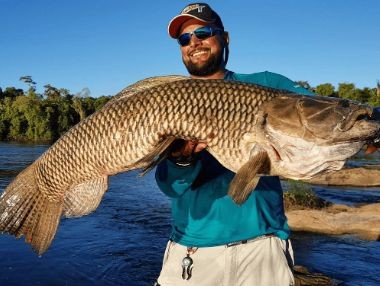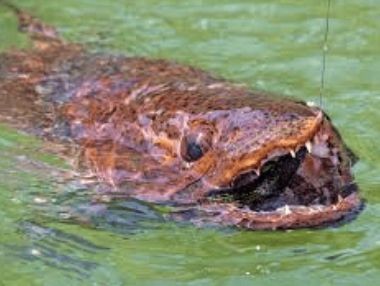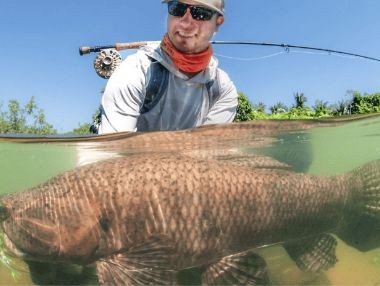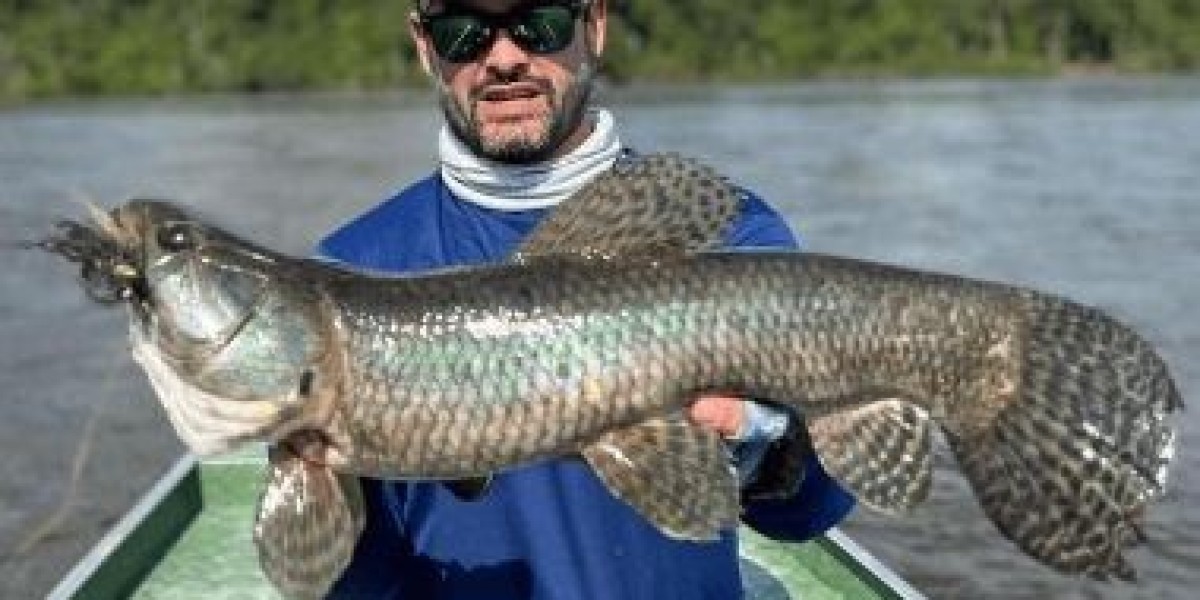Aside from name confusion, destination anglers may find this aggressive species to be the perfect jungle fish! Our humble opinion is that any daring angler's bucket list should include a trip to the Amazon to hunt wolf fish!
The most well-known of the wolf fish's subspecies is the giant wolf fish.
Fly anglers are especially interested in catching Giant Wolf Fish, and they will go to the center of the Amazon to do so. These fish can reach enormous lengths of about 5 feet (1.5 meters) and 80 pounds at their maximum size!
Fly fishermen who target giant wolf fish enjoy witnessing the creature's fierce pursuit of their flies. even poppers Once attracted, these cunning fish will put up a fierce final fight.
Overview of Wolf Fish on Amazon Wolf fish are ancient, prehistoric fish. Their eyes are looking upward, and their heads are flat in shape. Canine teeth, sharp as daggers, set in a large mouth, latch into anything that swims too close. Their lengthy, eel-like bodies taper from their enormous heads, and they are covered in thick, massive scales that extend to a strong tail. Subspecies of wolf fish vary in size; some reach a maximum length of 10 inches, while others reach enormous lengths.

Giant Wolf Fish are air-breathing fish, just like Arapaima and Tarpon! They frequently come up to the surface of the water and suck air. They have managed to survive in low-oxygen, stagnant waters because to their special adaption. There are rumors that these "air-breathers" slither over dry terrain between ponds! Breathing is perhaps the primary factor that has contributed to wolf fish's long history of genetic success.
What to Anticipate from Amazon Wolf Fish Fishing
Giant wolf fish are ambush predators that favor low-oxygen, slow-moving water. They are frequently caught by anglers in slow-moving rivers, lagoons, and backwater channels. Because of this propensity for murky or off-colored waters, fishing for these ferocious species is frequently done!
Anticipate a hunt:
Wolf fish frequently cling closely to structures throughout the day in order to ambush prey and hide from the sun! Underwater branches and logs, underwater plants, and rocky outcrops are some examples of the optimum kind of structure. Wolf fish become more active and start to stalk around when the light intensity decreases throughout the day. Sometimes all you have to do is look for them!
Be prepared for challenging casts since they adore structure! This typically indicates that wolf fish hide under protruding branches or indentations in the riverbank. In these cases, anglers must be ready to thread tight casts. Wolf fish are mostly ambush predators, thus in order to get them to eat, you must get your fly rather near to them!
Thankfully, they are not fussy eaters, so be prepared for aggressive eating. Wolf fish prioritize eating over asking questions; nonetheless, a well-chosen fly selection is still crucial! To get inside their bony mouths, you need flies with sharp hooks.
Be prepared to strip set:

A strong strip set is essential for any jungle fishing, including fly fishing for peacock bass and golden dorado. With these fish, raising the rod tip, also known as "trout setting," will not work. You maintain your fly in the game by stripping further because wolf fish occasionally miss the fly! They always put on a great show throughout the battle, so be prepared for a hard fight. Before engaging in bloody combat with death rolls and deep water dives, we adore witnessing them soar through the air like tarpons. Be careful with those teeth once you've landed!
Where to Look for Wolf Fish in South America?
Wolffish are found throughout South and Central America, thus there are many locations where they can be caught. Although huge wolf fish have a wide native range, most fly fishermen target them in Brazil, Guyana, or Venezuela. The majority of hotels that promise amazing wolf fish fly fishing are targeted at Brazilian tourists. At several smaller-scale resorts, however, western influence is starting to become apparent. We predict that additional western-style lodges will open up as wolf fish continue to gain popularity!
Alto Rio Trombetas:
The fabled Rio Trombetas is located deep within Brazil's jungle. Trophy wolf fish, payara, and peacock bass are abundant at this retreat. They could be a fly-fishing operation, even if they are not one!
What You Need to Fly Fish for Wolf Fish
There are numerous Giant Wolf Fish fisheries. Every site has distinct features and a variety of fish sizes. This merely indicates that a variety of fly tackle and gear are available that will be effective! For most jungle fishing, you will only ever need a fly rod that weighs between 7 and 9 weights. At least when it comes to Amazonian wolf fish, this is accurate! For flipping over the big streamers or poppers that these freshwater demons adore, we suggest using fast-action rods. Thus, acquire a corresponding reel!Present yourself with a few fly lines, please! The best option will be a floating fly line, but don't forget to pack additional intermediate lines! A sink tip line may be necessary for some fisheries, particularly during high water. As usual, carry a few extra fly lines because they rip fast in the forest!
What are some interesting facts about wolffish?

With the help of these amazing facts, explore the fascinating world of wolffish:
Fangs for Days:
The remarkable dentition of wolffish is well known. Because of their strong molars and menacing canines, they are known as the "wolf of the sea." Wolffish can easily shatter apart hard-shelled prey, such as crabs, lobsters, and sea urchins, because to their powerful mandibles. Certain wolffish even have noticeable canine teeth that stick out of their mouths, giving them the appearance of vampires in need of braces!
Wonderful Guardians:
Wolffish exhibit a level of familial commitment never seen before. The male wolffish carefully watches over their eggs for a staggering three to nine months before they hatch, in contrast to many other fish species that let their eggs fend for themselves.A greater chance of survival for the progeny is guaranteed by this prolonged time of shielding. While most wolffish species are found in salty water, some, such as the Northern wolffish, have been known to make brief excursions into brackish estuaries and sometimes even clean water rivers. They may take benefit of a variety of feeding opportunities due to their versatility.
Threatened by Change:
Sadly, there are a number of dangers to wolffish stocks. Their reduction is attributed to overfishing, habitat degradation, and accidental bycatch in commercial fishing gear. Conservation efforts depend on an understanding of their biological importance as bottom feeders in preserving healthy marine environments.
More Than Just Fangs:
Although their fangs are the main attraction, wolffish have additional intriguing characteristics. Their strong sense of smell is essential for finding prey in the dark depths. They may also hide themselves by changing the color of their skin to match their surroundings. These are only a handful of the fascinating details that make wolffish such fascinating animals. These "wolves of the sea" continue to pique the interest of scientists and ocean lovers alike due to their menacing look and distinctive adaptations.



